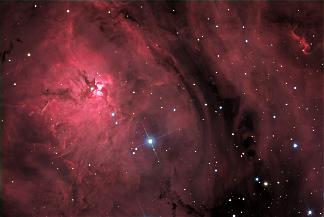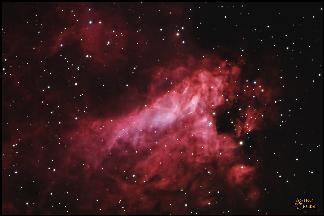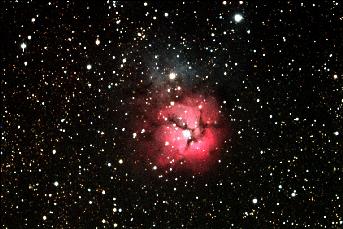Sagittarius
M8 - The Lagoon Nebula
M17 - The Omega or Swan Nebula
M20 and M21 - The Triffid Nebula and Open Cluster
Lying in the direction of the centre of the Milky Way, Sagittarius is one of richest constellations in the sky. Sadly, for observers in northern Europe, it tends to be lost low in the southern horizon during the short summer months. An excellent reason to travel to the southern hemisphere to observe it where it is high in the sky during the winter! Its main stars form the shape of a teapot. It contains 15 Messier objects, four of which have been included in the A-List.
M8 - The Lagoon Nebula Diffuse nebula and Open Cluster B L M
This is perhaps one of the most beautiful regions of the Milky Way. It lies just over 5 degrees to the west of and slightly north of Lambda Sagittarii (the top of the teapot's lid). So placing Lambda on the appropriate side of a binocular or finder field of view should bring M8 into the other side of the field. It is very hard to miss and, at about 5th magnitude, can be picked out using your eyes alone. The region is one and a half degrees wide with the main region of bright nebulosity at one end and a young open cluster, NGC 6530, towards the other. A dark east-west dust lane, most obvious at low and medium powers, may be why it was called the Lagoon Nebula, though it looks more like a river than a lagoon. The gas that glows in the bright emission regions is excited by the ultraviolet light from a very hot 6th magnitude star, 9 Sagittarii, and others, most of which are hidden by dust. The very brightest part of this region is named the 'hourglass nebula' after its shape. Though not seen in small telescopes, the nebula contains many small dark compact 'globules'. These are collapsing clouds of dust and gas, typically 10,000 AU across, which are new stars in their first stages of formation.
Position: 18h 03.6m -24deg 23min
M17 - The Omega or Swan Nebula Diffuse nebula B M
M17 has many names as well as the two most common ones, given above. It is also called the Horseshoe or Lobster nebula - the latter particularly in the southern hemisphere. As in all bright nebulae, it is shining as a result of gas being excited by the ultraviolet light emitted from the hot young stars embedded within it. It is found right at the northern edge of Sagittarius on the boundary with Scutum, 9 degrees north and a little west of the star Lambda Sagittarii, that delineates the top of the teapot's lid. So, starting with this star at the left (southern observers: right) of the field of a pair of binoculars or finder scope and move northwards from this star by about two field widths. This 6th magnitude patch of light, somewhat larger than the size of the full moon, is easily visible in binoculars and can even be picked out by the unaided eye under dark skies. A telescope shows the swan-shaped central region of the nebula whilst among fainter wisps of nebulosity below the swan, can be seen an open cluster of 9th magnitude blue stars. The brightest part of the nebula is about 15 light years across and contains sufficient gas to form hundreds of stars.
Position:
18h 20.8m -16deg 11min
M20 and M21 - The Triffid Nebula Diffuse nebula and Open Cluster B L M
M20 lies just north of the Lagoon nebula (see above as to how to find it) and will be encompassed with both M8 and the open cluster M21 in a single 2 degree field – as can be observed by most small telescopes at low power. It was discovered by Charles Messier in 1764. He described it as a cluster of eighth to 9th magnitude stars within an envelope of nebulosity. It is called the Trifid Nebula, as it is seemingly split into three segments by dust lanes that radiate from the bright central region. It also looks like a clover leaf. Colour photographs show that as well as the emission nebulosity that appears red in photographs (emitted by excited hydrogen), there is also an extensive blue reflection nebula on its northern side. Moving north-east by one degree from M20 is M21, a 6.5 magnitude open cluster containing about 60 stars. There is a strong concentration towards its centre. The brightest stars are of type B0 – giant stars that have very short lives – so we know that this cluster must be very young, perhaps only 4.6 million years old.
Positions
M20: 18h 02.6m -23deg 02min
M21: 18h 04.2m -22deg 30min






